CBSE Class 6 Science Notes Chapter 9 The Living Organisms Characteristics and Habitats
CBSE Class 6 Science Notes Chapter 9 The Living Organisms Characteristics and Habitats are given below. Our notes are designed by the subject experts and are as per the NCERT guidelines. These notes include all the important points of the chapter in detailed way, so you can refer to this whenever required. Study Path provides CBSE Class 6 Science Notes Chapter 9 that are easy to understand and also free downloadable PDF format, so students can practice it for their studies and get good marks in their examinations.
The Living Organisms Characteristics and Habitats Class 6 Notes Science Chapter 9
Introduction
We all are surrounded by plants, trees, animals, birds, microbes, and other living and non-living things based on certain parameters, Scientists were able to differentiate between living and non-living things.
Organisms
An organism is simply defined as any living thing, ranging from microscopic bacteria to large elephants and everything in between.
- Different types of plants and animals are found in different areas.
- E.g. deserts have camel and cacti as plants.
- Beaches show coconut trees and crabs.
- Fishes and other marine animals inhabit the sea.
Characteristics of Living Organisms
- Living beings are made of cells.
- Living beings obtain and use energy.
- Living beings grow and develop.
- Living beings reproduce.
- Living beings adapt to their environment
- Living beings respond to their environment or stimuli.
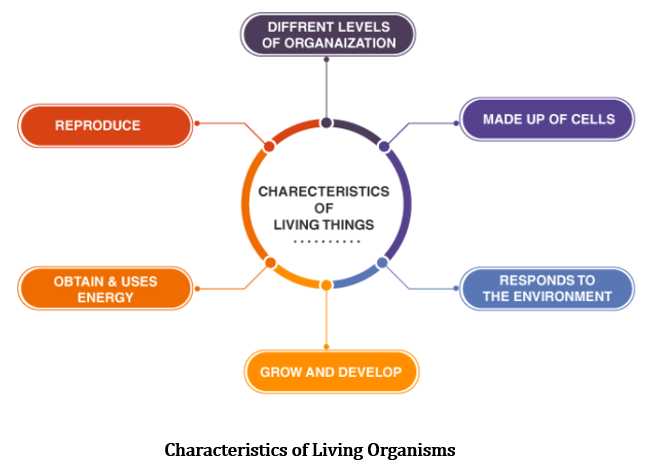
Nutrition
- The process by which animals obtain food and utilize it for all the activities is called as nutrition.
- Every organism requires nutrition for obtaining energy.
Growth
- All living organisms grow and exhibit growth in different ways.
- Their body cells divide and grow and thus overall growth is attained.
Respiration
- Respiration is necessary for all living organisms.
- It is through respiration that the body finally obtains energy from the food it takes.
- Some animals may have different mechanisms for the exchange of gases, which is a part of the respiration process.
- E.g., earthworms breathe through their skin and fish have gills for using oxygen dissolved in water.
- In humans, we respire by breathing in oxygen breathing out the carbon dioxide.
Response to Stimulus
- Changes in our surroundings that makes us respond to them are called stimuli.
- All living beings react to changes in their surroundings.
- E.g., In response to increased temperature in summer, we use fans to cool our homes.
Excretion
- All living things take food.
- Not all the food that is eaten is really used, only a part of it is utilised by the body.
- Unused/remaining food becomes waste and needs to be excreted.
- Our body also produces some wastes, like urea, in other life processes.
- Living organisms get rid of all this waste material and the process is known as excretion.
Reproduction
- All living organisms give rise to a new organism of their own kind, by a process called reproduction.
- The mode of reproduction may be different, in different animals and plants.
- Some animals produce their young ones through eggs.
- Some animals give birth to the young ones.
- Plants produce seeds which germinate into new plants.
- Some plants also reproduce through parts other than seeds.
- E.g.: a part of a potato with a bud, grows into a new plant
Movement
- Animals move from one place to another and also show other body movements.
- Plants are generally anchored in the soil so they do not move from one place to another.
- However, various substances like water, minerals and the food synthesised by the plants move from one part to other.
- Plants also show other kinds of movement like the opening and closing of flower buds.
Adaptation
The presence of specific features or certain habits, which enable a plant or an animal to live in its surroundings, is called adaptation.
- Different animals are adapted to their surroundings in different ways.
- Eg: Fish have slippery scales on their bodies.
- These scales protect the fish and also help in easy movement through water.
Surroundings
- The different surroundings or areas have different organisms that live in.
- E.g.: The deserts have camels, the mountains have goats and yak.
Habitat
The surrounding where living organisms survive is known as habitat.
- The organisms depend on their habitat for their food, water, air, shelter and other needs.
- Habitat means a dwelling place (a home).
- Several kinds of plants and animals may share the same habitat.
Environment: Everything that we see surrounding us; living, non-living, physical, chemical etc. is called as environment
Biotic Components: These are the living components of the ecosystem. e.g. flora and fauna
Abiotic Components: The non-living components of the ecosystem like soil, water ,air etc. are called abiotic components.
Habitat and Adaptation
The region or place where an organism lives is termed as its habitat. Habitat provides an organism everything it needs to survive like food, shelter, proper weather conditions such as rainfall, heat etc to breed and flourish.
Camel:
- It has long legs which provide protection from the heat of sand
- Excrete small quantity of urine
- They do not sweat and their dung is dry
- Can live without water for many days as their bodies lose little water.
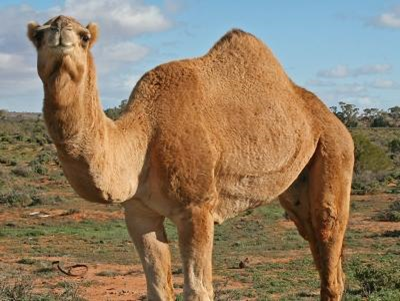
Fish:
- Their streamline shape helps to move easily in water
- Presence of slippery scales
- Gills help in utilizing dissolved oxygen
- Flat fins and tail help in changing direction in the water
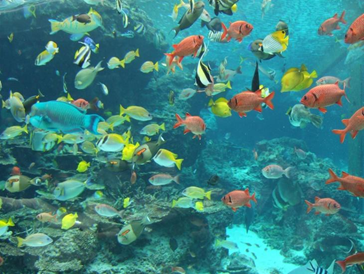
Both the organisms discussed above have specific features or characteristics that enable them to survive in their habitat. These features are termed as adaptations.
| Terrestrial Habitat | Aquatic Habitat |
| Plants and Animals that thrive on land said to live in terrestrial habitat. | Plants and Animals that thrive in water said to live in aquatic habitat. |
| E.g.: forests, deserts, mountain regions | E.g.: rivers, lakes |
Journey through different habitats
Terrestrial Habitat:
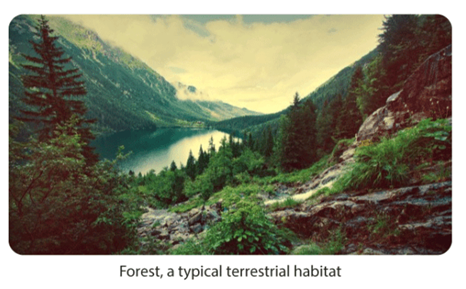
(a) Deserts:
The following adaptations of various organisms are enlisted below:
- Snakes and rats dig burrows to escape intense heat as they dont have long legs such as a camel. These animals come out only during the night, when it is cooler
- In desert plants leaves are reduced to spines and lose little water through transpiration
- The stems of desert plants have a waxy coating on them and in most of them photosynthesis is carried out by the stem
- Their roots go deep into the soil so as to absorb water.
- The leaves in desert plants are absent to prevent loss of water due to transpiration.
- Some of the animals are camels, kangaroo rats etc
(b) Mountain Regions:
- The trees are cone shaped with slope like branches, also needle-like leaves are present so that rain and snow slide off them easily.
- Animals have thick fur which provides protection from cold. e.g. Snow Leopard
- Presence of strong hooves help the mountain goat to run on the rocky slopes.
- Eg are Pines, mountain goats, yaks, sheep etc. Yaks have long hair to keep them warm.
(c) Grasslands:
- The light brown colour of the lion helps it to hide in dry grasslands and the presence of long claws help to capture the prey.
- Deer has strong teeth to eat plant stems also its long ears help to listen to predator movement. They have eyes on its sides of the head which help them to look in all directions to lookout for danger.
- Some of the animals living in these habitats are elephants, giraffes, lions .
(d) Rainforest:
- This habitat receives a lot of rain and hence its rich in animal life.
- Mammals, Amphibians, Reptiles all sorts of animals are found here.
- The climate is hot and humid and animals have to learn to adapt to survive.
(e) Polar Habitat:
- These habitats are very cold and windy.
- The animals are mostly carnivores and have thick fur to survive in cold.
- Some blend in ice and some may hibernate in the coldest months.
- Examples of animals are polar bears, reindeers, penguins etc.
Aquatic Habitat
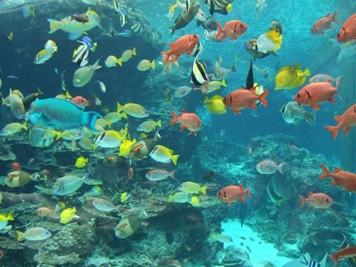
(a) Marine Habitat
- Marine Habitat comprises of oceans and seas, and both have saltwater.
- They are home to a wide variety of creatures like the most part of fish population is found here.
- Marine creatures are found in Estuaries – where rivers and oceans meet and the water is salty.
- Marine Mammals like whales migrate to long distances in order to cope up with the temperature changes.
(b) Oceans
- Most organisms have streamlined bodies and gills
- Octopuses do not have streamlined bodies so they stay deep in ocean, but when moving they make a streamline motion.
- Whales have blowholes instead of gills This enables them to breathe easily when they swim near the surface of water.
(c) Freshwater Habitat:
- Rivers, lakes, ponds etc comprise the freshwater habitats.
- Three percent of world’s water is accounted as freshwater but still a wide variety of species are found here.
- Snails, worms, mollusks etc are found in this habitat
(d) Ponds and Lakes:
- Plants: Water plants can be completely submerged in water (like Hydrilla) or floating on the surface of water(like Water Lily, Lotus, Water Hyacinth). Roots are much reduced in size, since their main function is to hold the plant in place. Stems of aquatic plants are long, hollow and light so that these can bend in along with water movement. e.g Water Lily. The stems grow up to surface of water, while the leaves and flowers float on surface of water.
- Totally submerged plants have narrow and ribbon like leaves (e.g tape grass). These can bend in flowing water.
- Stems have air spaces to enable the plant to float. Floating plants are large and flat. They have waxy upper surfaces that makes them waterproof. They have stomata on the upper surfaces which are exposed to air.
- Frogs are adapted to live both on land and water, they have strong back and legs and webbed feet which allows them to swim in water.
(e) Coastal Habitat:
- Habitats where the land meets the sea.
- Beaches, special type of trees called mangroves are found in this habitat
- Coastal plants like seaweed attach to the rocks firmly so that they are not swayed by the waves,
Acclimatisation: Due to certain changes in the surroundings, organisms adapt through them by making small changes in the body over short periods of time.
For e.g: The changes which take place in the body when we travel from plains to mountains. The adjustment which the body makes is called Acclimatisation
Revision Notes for CBSE Class 6 Science Chapter 9 – Free PDF Download
Our Class 6 Revision Notes will provide a quick glimpse of the chapter and improve the learning experience. We have made these revision notes keeping the convenience of students in mind so that it proves more effective. You can easily read these Class 6 notes just by clicking on the chapter names provided above.